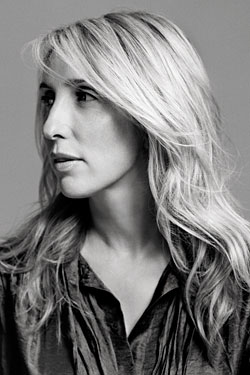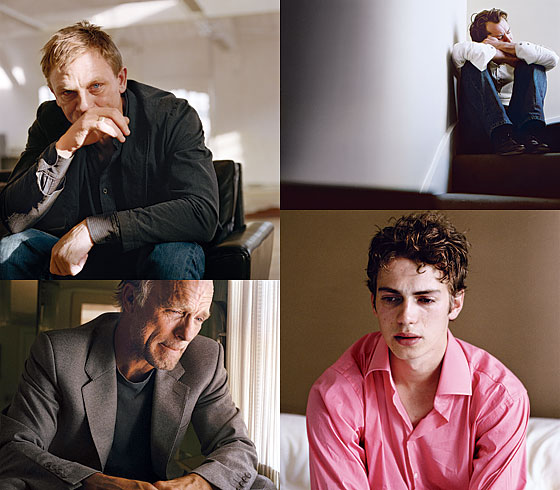
I might have to breast-feed in the middle of this. Is that okay?” asks British artist and filmmaker Sam Taylor-Wood, arriving for lunch. In tow are her fiancé, actor Aaron Johnson (star of last spring’s Kick-Ass), and their 10-week-old daughter, Wylda Rae. After a brief discussion, it’s decided that father and child will go window-shopping while we talk. “It’s been challenging,” says Taylor-Wood, waving them off. “Newborn baby, jet lag, breast-feeding, raging hormones, and press conferences. I sleep on average every other hour and try not to burst into tears in the day.”
The couple met when Johnson auditioned for the title role in Nowhere Boy, Taylor-Wood’s feature directorial debut about the teenage years of John Lennon, when the soon-to-be Beatle yo-yoed between his purse-lipped Aunt Mimi (Kristin Scott Thomas), who essentially raised him, and his mother, Julia (Anne-Marie Duff), a flame-haired siren who died in a car accident when he was 17, thereafter ascending to the status of ghostly unattainable love object, like Dante’s Beatrice or Dylan’s “Sad-Eyed Lady of the Lowlands.” We are, in other words, at Lennon’s personal ground zero: dead center in the hurt zone.
“What we focused on was the journey from youthful innocence to the man who’s gone through such pain and anger and anguish, who’s more recognizable as the Lennon that we know,” says Taylor-Wood. “So by the time you get to the end, you’re completely convinced of his Lennonism.” The film was praised by critics upon its release in the U.K. (it opens here October 8) but got squashed by Avatar at the box office, while the Oedipal longings onscreen were overshadowed by the tabloid screech over Taylor-Wood’s relationship with Johnson: He was 18 at the time of shooting, making him 23 years her junior.
“We were both aware that something was happening while we were working but too terrified to let it happen while we were at work,” she says. “A woman going out with a younger man feels like the last taboo. We’re happy and we’re in love, and our life is working out well. We’re not hurting anyone. What’s the issue? Other than curiosity, I suppose. Or jealousy. Britain can sometimes feel like a very small village, and you’re this, I dunno, scarlet woman they’re all gossiping about.”
A long-faced English beauty of 43 in a Marc Jacobs shirt and Christian Louboutin high heels, her speech peppered with “I dunnos,” Taylor-Wood is a disarming blend of the immaculate and the chummy—one of those women who always seem to emerge, Venus-like, from a dust cloud of companionable chaos. She is most famous in Britain for her work exploring the soft underbelly of celebrity: her series of photographs showing famous actors crying; a video installation of soccer superstar David Beckham sleeping. For eleven years, beginning in 1997, she was the wife of Jay Jopling, the charismatic art impresario who helped launch the careers of Damien Hirst, Tracey Emin, and the Chapman brothers. The British art scene’s highest-wattage power couple, they were famous for the parties they threw at their Georgian house in Marylebone.
“She has that ability to make people feel really at ease,” says Elton John, who first met Taylor-Wood at a Pet Shop Boys concert in the nineties and subsequently became godfather to her second daughter with Jopling. “When I first met her, it was like we’d been best friends since we were schoolkids. When it was announced that Sam and Jay were going to get divorced, Neil Tennant said it was a blow for the whole of London because they seemed to be the eternal couple.”
Taylor-Wood’s personal background is much less starry than such stories suggest. Her childhood in South London roiled with positively Lennonesque levels of abandonment. When she was 9, her chartered-surveyor father got involved with the Hells Angels, leaving Taylor-Wood and her two siblings in a hippie commune with their yoga-instructor mother. Then, when the artist was 15, her mother left her children with their stepfather and moved in with a new boyfriend a few streets away. “Never trust a hippie,” says Taylor-Wood. “That’s definitely my motto. I remember as a kid not ever wanting to have friends around to my house because it was, for want of a better description, disheveled. Cat shit everywhere—cats and dogs and chickens and rats and hippies. I was determined to have a spotless house when I grew up. I struggle if I have chaos around me, but at the same time, if I don’t have it, I’m uncomfortable. It’s a strange thing: If I don’t have chaos, I create it.”
A series of photographic self-portraits from 2004 show her suspended in midair, the images themselves poised between tranquillity and violence—is she floating or falling? Her life and work have flourished amid such ambiguities. Being married to a top art dealer, in some ways, got her career off to a slow start; it was hard to escape Jopling’s shadow. Then, in 1997, after being nominated Most Promising Young Artist at the Venice Biennale and giving birth to her first child, Angelica, Taylor-Wood was diagnosed with colon cancer. Doctors had to remove a foot and a half of her intestine. She described her life at the time as “drips by day, Prada by night.” But after a recurrence of the cancer, in 2000, metastasized to her breast, necessitating a mastectomy, she “took it on like I took on a job,” cutting out the parties and alcohol, not going out for a year and a half, hunkering down to look after herself.

From the "Crying Men" series.
Clockwise from top left: Daniel Craig, Jude Law, Hayden Christensen, and Ed Harris. Photo: Courtesy of Sam Taylor-Wood and White Cube
“I think it put a strain on the marriage,” says John. “She saw things in a completely different way [the second time she got cancer]. She changed her priorities. She didn’t want to go out so much. She put a lot of it into her work. She did that still life of the trees, which is one of the most beautiful pictures she’s ever done. Her work got really beautiful.” Most of Taylor-Wood’s best-known work dates from this period: her 2002 “Crying Men” series, including Paul Newman, Ryan Gosling, Daniel Craig, and Jude Law; the stark, arresting video she shot for John’s song “I Want Love,” featuring Robert Downey Jr. lip-synching the words; her 2004 video portrait of Beckham, commissioned by the National Portrait Gallery, which shows him sleeping after a training session in Madrid, his hands tucked sweetly beneath his head, like an eighteenth-century shepherd. Taylor-Wood’s sweet tooth for celebrity has garnered her some criticism. But whereas Andy Warhol coolly anatomized the desire instilled in us by the famous, Taylor-Wood’s work takes in the whole range of emotions—protective, proprietary, maternal—that fan out around these tenderized icons.
“With the ‘Crying Men’ series, I was literally making them shed the tears for me,” she says, “because I was so stoic throughout [the cancer treatment]. It’s nothing to do with bravery. The people that die do not die because they are cowards. But you get tunnel vision. I developed a core of steel to get through it. And then once you’re better and everything falls away, you still have this tunnel-vision focus, but you’ve got no outlet for it. I found that incredibly unnerving and frustrating at first. That’s when it shifted to my work. Pre-cancer, I wouldn’t have had the balls to make a movie. I had the tits. Well, one tit,” she says with a laugh. “But not the balls.”
Nowhere Boy might swap the high-concept chic of the art world for the more staid conventions of the biopic, but thematically it is of a piece with her previous work. The word “Beatles” is never uttered in the film. Taylor-Wood deliberately stayed away from real footage of Lennon in her research (“If you look at him when he sang ‘Twist and Shout,’ it was through tight lips and gritted teeth, this very defensive stance”), zeroing instead on Yoko-era Lennon, when he was “much more innocent and wide-eyed and optimistic again.” While Ono has given the film her blessing, Paul McCartney had some objections, particularly to a fictional scene in which Lennon bloodies McCartney’s nose. “He hated it,” says Taylor-Wood. “I told him it was the only way to get the two of them embracing at the end of the scene.”
The film comes so packed with Taylor-Wood’s signature issues that some Beatles fans may feel Lennon slips out of focus. Was he really such a walking bruise? What happened to the famously biting wit? “I’m very conscious that there are Lennon obsessives out there who know every single detail down to buttons and shoelaces. I just know somebody is going to come up to me and say that guitar string was actually 1962 not 1957,” says Taylor-Wood, who does not pretend to be a die-hard fan, even though she once replicated an Annie Leibovitz photo of John and Yoko. “What I connected with was the way Matt Greenhalgh’s script was trying to get to grips with Lennon, who he was and how he became who he was, and the retreat into imagination during a turbulent childhood. I definitely connected with that—the retreat into imagination and the turbulence.”
As she’s finishing that thought, Johnson reappears at the restaurant’s window clutching their little girl, who is fast approaching a little turbulence of her own. “Oh, look. There’s Daddy,” she says. “I might have to go. Sorry, there’s nothing like a screaming baby to make a mother twitch.”